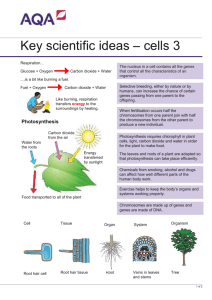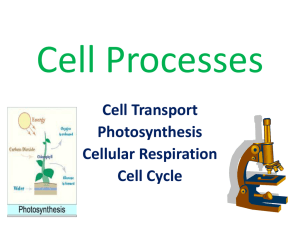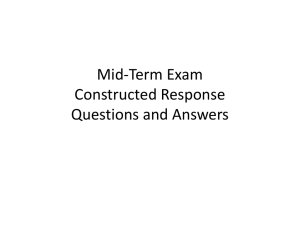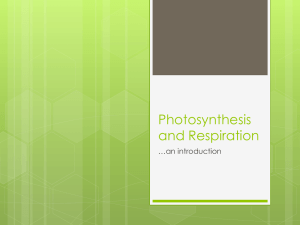review
advertisement
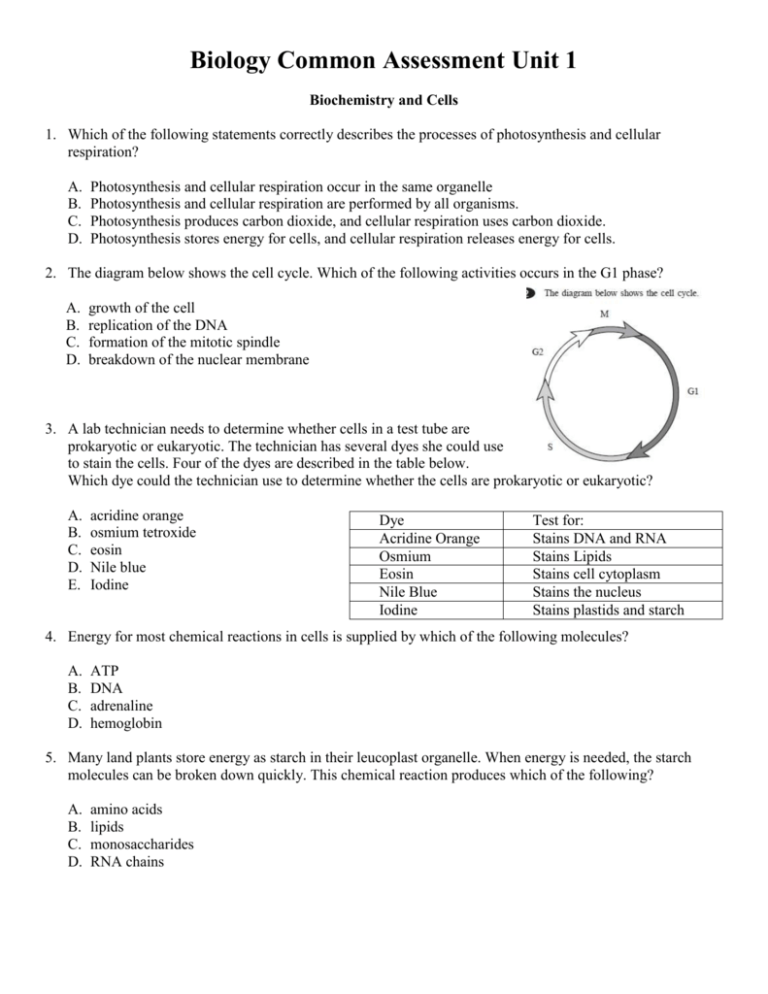
Biology Common Assessment Unit 1 Biochemistry and Cells 1. Which of the following statements correctly describes the processes of photosynthesis and cellular respiration? A. B. C. D. Photosynthesis and cellular respiration occur in the same organelle Photosynthesis and cellular respiration are performed by all organisms. Photosynthesis produces carbon dioxide, and cellular respiration uses carbon dioxide. Photosynthesis stores energy for cells, and cellular respiration releases energy for cells. 2. The diagram below shows the cell cycle. Which of the following activities occurs in the G1 phase? A. B. C. D. growth of the cell replication of the DNA formation of the mitotic spindle breakdown of the nuclear membrane 3. A lab technician needs to determine whether cells in a test tube are prokaryotic or eukaryotic. The technician has several dyes she could use to stain the cells. Four of the dyes are described in the table below. Which dye could the technician use to determine whether the cells are prokaryotic or eukaryotic? A. B. C. D. E. acridine orange osmium tetroxide eosin Nile blue Iodine Dye Acridine Orange Osmium Eosin Nile Blue Iodine Test for: Stains DNA and RNA Stains Lipids Stains cell cytoplasm Stains the nucleus Stains plastids and starch 4. Energy for most chemical reactions in cells is supplied by which of the following molecules? A. B. C. D. ATP DNA adrenaline hemoglobin 5. Many land plants store energy as starch in their leucoplast organelle. When energy is needed, the starch molecules can be broken down quickly. This chemical reaction produces which of the following? A. B. C. D. amino acids lipids monosaccharides RNA chains 6. The fungus Penicillium reproduces asexually and forms genetically identical spores. Which of the following processes does Penicilium use to form its spores? A. B. C. D. fertilization mitosis osmosis transcription 7. Which number on the cell diagram identifys the organelle that functions to store water and dissolved salts? A. 1 B. 2 C. 3 D. 4 8. Trichodina is a eukaryotic organism that attaches itself to fish and eats the bacteria off of fish. Which of the following distinguishes Trichodina from all prokaryotes? A. B. C. D. Trichodina is unicellular Trichodina has a nucleus Trichodina has cytoplasm Trichodina is heterotrophic 9. In a cell, which of the following organelles most likely contains digestive enzymes? A. B. C. D. Centriole Chloroplast Lysosome Ribosome 10. One category of organic compounds contains molecules composed of long hydrocarbon chains. The hydrocarbon chains may be saturated or unsaturated. Which of the following categories of organic compounds contains these molecules? A. carbohydrates B. lipids C. nucleic acids D. proteins 11. Some bacteria contain a substance called nitrogenase. Nitrogenase catalyzes the chemical reaction that converts atmospheric nitrogen (N2) into ammonia (NH3). Nitrogenase is an example of which of the following? A. a sugar B. an enzyme C. a nucleotide D. an amino acid 12. Which of the following categories of organic molecules is correctly paired with one of its functions? A. nucleic acids-digest dead cells B. lipids-give quick energy to cells C. carbohydrates-store genetic information D. proteins-provide structure in skin, hair, and nails 13. Which of the following best describes the formation of a zygote? A. A sperm cell nucleus and an egg cell nucleus fuse. B. A cell’s DNA replication and mitosis are accelerated. C. A succession of cell divisions produces a solid mass of cells. D. A cell with 46 chromosomes divides to form cells with 23 chromosomes each. 14. Which of the following is a main function of the cell wall? A. to store carbohydrates for later use B. to give the cell a rigid structure C. to package proteins for export D. to carry out photosynthesis 15. Which of the following statements correctly matches a cell part with its function? A. The cell membrane packages lipids for export. B. The mitochondria perform photosynthesis. C. The lysosome digests molecules. D. The nucleus produces energy. 16. Prokaryotes are structurally simple organisms that have existed for over two billion years. Which of the following are prokaryotes? A. bacteria B. fungi C. plants D. protists 17. The table below provides information about nutrition and the cellular structure for organisms in different kingdoms. Kingdom Nutrition Nucleus Fungi Plantae Animalia heterotrophic autotrophic ? yes yes ? What information completes the table? A. Autotrophic, no, unicellular B. Autotrophic, yes, multicellular C. Heterotrophic, no, unicellular D. Heterotrophic yes, multicellular Unicellular or Multicellular unicellular multicellular ? 18. A student is looking at a picture of a cell taken through a microscope. The presence of which of the following would indicate that the cell is eukaryotic? A. cytoplasm B. DNA C. nucleus D. plasma membrane 19. A student is investigation how a reaction rate changes over a range of enzymes concentrations. The student uses excess reactants,. Which graph below would show the relationship between enzyme concentration and reaction rate? A B. C. D. 20. Acetylcholine is an important chemical signal in the nervous system. Once acetylcholine is released, it is quickly broken down into other chemicals because of the activity of cholinesterase. Cholinesterase is which of the following? A. a hormone B. a lipid C. an enzyme D. an organelle 21. Ovalbumin is a protein found in eggs. Which of the following best describes the molecular structure of ovalbumin? A. a group of six carbon atoms joined in a ring. B. a chain of amino acids folded and twisted into a molecule. C. a set of three fatty acids attached to a molecule of glycerol. D. a sequence of nitrogenous bases attached to a sugar-phosphate backbone. 22. A tomato plant in a greenhouse was found to be infected with tobacco mosaic virus. A few weeks later, nearby plants were also found to be infected with the virus. Which of the following best describes how the virus reproduced? A. The virus made its own spores. B. The virus produced seeds in the tomatoes. C. The virus used the host plant’s resources and machinery to reproduce. D. The virus immediately killed the host plant and was free to reproduce. 23. The diagram to the side is of an organic molecule. What is the dot on the molecule and what type of molecule is this? A. B. C. D. Carbon, lipid Nitrogen, amino acid Phosphorus, carbohydrate Sulfur, nucleic acid 24. When gametes are produced from a parent cell during normal meiosis, which of the following describes the number of chromosomes in each resulting cell? A. Each resulting cell has the same number of chromosomes as the parent cell. B. Each resulting cell has twice the number of chromosomes as the parent cell. C. Each resulting cell has on-half the number of chromosomes as the parent cell. D. Each resulting cell has one-fourth the number of chromosomes as the parent cell. 25. Which organism above is eukaryotic, multicellular, and autotrophic? 26. With enzymes, pH, concentration of substrate, and temperature can affect reaction rate. Which graph below would show the effect of temperature on a reaction? A Temperature B Temperature C Temperature 27. Lactose is the sugar found in milk. What type of molecule is lactose? What is it broken down into by the lactase? A. Lactose is a protein is broken into two amino acids. B. Lactose is a Carbohydrate is broken down into monosaccharides. C. Lactose is a carbohydrate that is broken down into polysaccharides. D. Lactose is a saturated fat that is broken down into two lipids. 28. What is lactase? A. A protein that breaks down lactose into glucose and galactose. B. A carbohydrate that breaks down glucose into galactose and lactose. C. A protein that turns galactose and glucose into lactose. D. An enzymes that turns glucose and galactose into lactose. 29. Below is a picture of paraffin wax. Using the diagrams below as a guide, decide if paraffin is most like a protein, carbohydrate, lipid or nucleic acid. Look at the backbone of each molecule. Wax will have a similar carbon backbone. Paraffin Wax Protein D. Carbohydrate Structure B. DNA Structure C. Lipid Structure 30. What organelle is only found in plant cells? A. Plastids (chloroplasts, leucoplasts, chromoplasts) B. Endoplasmic Reticulum C. Chromatids D. Mitochondrion 31. What is the function of each of the organelles below? Match the letter and the number together. K. . Stores food, water, and wastes. It gives support to soft structures, such as leaves. L. . Digestive system of the cell, serving both to degrade material taken up from outside the cell and to digest obsolete components of the cell itself. M. The production of ATP during cellular respiration. N. modify, sort, and package proteins and other materials from the endoplasmic reticulum and more often for the export from the cell. 1. Lysososome 2. Mitochondrion 3. Large Vacuole 4. Golgi Apparatus A. B. C. D. E. ( 1 and L ) ( 1 and L ) ( 1 and L ) ( 1 and M ) ( 1 and K ) ( 2 and K ) ( 2 and N ) ( 2 and M ) ( 2 and L ) ( 2 and L ) ( 3 and M ) ( 3 and M ) ( 3 and K ) ( 3 and K ) ( 3 and N ) (4 and N) (4 and K) (4 and N) (4 and N) (4 and M) 32. What type organism meets this description? It has an outer protein coated cell wall. It has either DNA or RNA but not both. It does not carry out cellular respiration. It is parasitic, mostly attacking animals and a few species of plants. A. B. C. D. E. Fungus Virus Bacteria Archaeobacteria Plant 33. Which one of these cells shown to the side is prokaryotic and which is eukaryotic? These pictures are not to scale. In real life, one cell is much smaller than the other type of cell. A. Cell 1 is prokaryotic and cell two is eukaryotic. B. Cell 1 is eukaryotic and cell 2 is prokaryotic Cell 1 Cell 2 34. The circles in the U-shaped tube has two different concentrations of sugar. Since sugar is too large to fit through the semi-permeable membrane, what will happen (if anything) to the volumes (solution levels) on each side? Chose the MOST correct answer. A. The solution level on the left will increase slightly because water will move across the concentration gradient. B. The solution level on the left will decrease by about 50% because water will move across the concentration gradient. C. The solution level on the right will remain the same because sugar will move across the concentration gradient. D. The solution level on the right will increase slightly because sugar will move across the concentration gradient. 35. What are the 5 most common elements in living creatures? A. Carbon, Calcium, Oxygen, Hydrogen, Chlorine B. Carbon, Nitrogen, Calcium, Magnesium, Oxygen C. Carbon, Phosphorus, Potassium, Nitrogen, Calcium D. Carbon, Hydrogen, Oxygen, Phosphorus, Nitrogen E. Carbon, Magnesium, Iron, Potassium, Helium 36. Of the 5 most common elements, which is the most abundant in all of the organic molecules? A. Carbon B. Hydrogen C. Magnesium D. Oxygen E. Calcium 37. What does the sodium-potassium pump ion channel found in the cell membrane to the right demonstrate? A. Osmosis B. Active Transport C. Passive Transport D. Facilitated Diffusion 38. What are the end products of photosynthesis and cell respiration? A. Photosynthesis products: glucose, CO2, Water Respiration products: O2, ATP energy, Glucose B. Photosynthesis products: CO2, Water Respiration products: CO2, ATP energy, Glucose C. Photosynthesis products: ATP energy, CO2 O2 Respiration products: O2, ATP energy, Glucose D. Photosynthesis products: glucose, O2 Respiration products: CO2, ATP , H2O 39. Normally, glucose molecules are shown as a ring as shown in the first picture. Sometimes, it is drawn with the carbons in a straight line or just showing the carbons, as in the gycolysis picture. All three pictures demonstrate that there are 6 carbons in the glucose molecule . What are the end products of gycolysis? A. B. C. D. 1 pyruvate molecules (CCC), 4 ATP 1 glucose molecules (CCCCCC) 2ATP 2 pyruvate molecules (CCC), 2 ATP gained, 2NADH +H 2 pyruvate molecules (CCC), 4 ATP gained, 2NAD+ 40. Which below goes against the concentration gradient? Use the diagram to the right to help you. A. B. C. D. Diffusion only Facilitated diffusion and Active Transport Active transport only Diffusion and Facilitated diffusion 41. In a molecule of double stranded DNA, the amount of adenine present is always equal to the amount of A. Cytosine B. Guanine C. Thymine D. Uracil 42. The mold Aspergillus flavus grows on grain. A. flavus produces a toxin that binds to DNA in the bodies of animals that eat the grain. The binding of the toxin to DNA blocks transcription, so it directly interferes with the ability of an animal cell to do which of the following? A. Transport glucose across the cell membrane into the cytoplasm. B. Produce ATP using energy released from glucose and other nutrients C. Transfer proteins from the endoplasmic reticulum to Golgi complexes. D. Send protein-building instructions from the nucleus to the cytoplasm and ribosomes. 43. The diagram to the right represents the beginning and end products of a process that occurs in the nucleus of a cell. Which process does the diagram represent? a. b. c. d. recombination replication transcription translation 44. In the diagram to the right, What is going on at stage X and stage Y? E. X is translation, Y is transcription F. X is transcription, Y translation G. X is translation, Y protein synthesis H. X is cloning, Y is translation 45. If the mRNA sequence was AUG AAA UUU UGG GCU GGC UAG, compare to the mRNA above and determine what is being shown in the mRNA sequence. A. B. C. D. 46. It shows a chromosomal mutation It shows protein synthesis It shows a point mutation substitution. It shows a point mutation insertion. The diagram to the right represents part of a process that occurs in cell. Which process is represented? a. b. c. d. meiosis osmosis replication translation 47. If a guinea pig has 64 chromosomes, how many are found in the gamete (sex cells) and how many will be in the offspring of a fertilized egg(zygote)? A. B. C. D. There will be 64 chromosomes in the gamete cells and 64 in the zygote. There will be 64 chromosomes in the gamete cells and 32 in the zygote. There will be 32 chromosomes in the gamete cells and 64 in the zygote. There will be 32 chromosomes in the gamete cells and 32 in the zygote. 48. Use the image below to guide you. What is the name of the type of cell called at the end of fertilization of the egg? A. B. C. D. Clone Egg Sperm Zygote 49. How many chromosomes are in each cell shown in the diagram below? A. The sperm is 2N (haploid). The egg in 2N(Diploid) and the fertilized egg is 4N(Quadriploid) B. The sperm is N (Diploid). The egg in 2N(Diploid) and the fertilized egg is 2N(Diploid) C. The sperm is 2N (Diploid). The egg in 2N(Diploid) and the fertilized egg is 4N(haploid) D. The sperm is N (haploid). The egg in N(Haploid) and the fertilized egg is 2N(Diploid) 50. Which type of cell below transmits a disease from one generation to the next and which transmits disease from one person in contact with another? Kidney Cells Egg cells Nerve cells Blood cells, A. Nerve cells transmit by contact and kidney cells transmits genetically B. Blood cells transmit by contact and egg cells transmits genetically C. Egg cells transmit by contact and blood cells transmits genetically D. Kidney cells transmit by contact and blood cells transmits genetically

